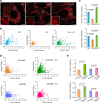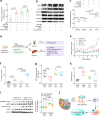Mitochondrial ATP synthase as a direct molecular target of chromium(III) to ameliorate hyperglycaemia stress
- PMID: 36977671
- PMCID: PMC10050403
- DOI: 10.1038/s41467-023-37351-w
Mitochondrial ATP synthase as a direct molecular target of chromium(III) to ameliorate hyperglycaemia stress
Abstract
Chromium(III) is extensively used as a supplement for muscle development and the treatment of diabetes mellitus. However, its mode of action, essentiality, and physiological/pharmacological effects have been a subject of scientific debate for over half a century owing to the failure in identifying the molecular targets of Cr(III). Herein, by integrating fluorescence imaging with a proteomic approach, we visualized the Cr(III) proteome being mainly localized in the mitochondria, and subsequently identified and validated eight Cr(III)-binding proteins, which are predominately associated with ATP synthesis. We show that Cr(III) binds to ATP synthase at its beta subunit via the catalytic residues of Thr213/Glu242 and the nucleotide in the active site. Such a binding suppresses ATP synthase activity, leading to the activation of AMPK, improving glucose metabolism, and rescuing mitochondria from hyperglycaemia-induced fragmentation. The mode of action of Cr(III) in cells also holds true in type II diabetic male mice. Through this study, we resolve the long-standing question of how Cr(III) ameliorates hyperglycaemia stress at the molecular level, opening a new horizon for further exploration of the pharmacological effects of Cr(III).
© 2023. The Author(s).
Conflict of interest statement
The authors declare no competing interests.
Figures




References
-
- Maret W. Chromium supplementation in human health metabolic syndrome, and diabetes. Metal Ion Life Sci. 2019;19:231–235. - PubMed
-
- Vincent, J. B. Introduction: a history of chromium studies. The Nutritional Biochemistry of Chromium(III) 2ndEdition, 1–20 (2018).
Publication types
MeSH terms
Substances
LinkOut - more resources
Full Text Sources
Medical
Molecular Biology Databases

